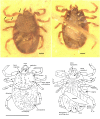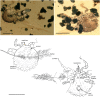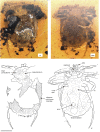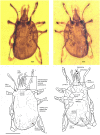A remarkable assemblage of ticks from mid-Cretaceous Burmese amber
- PMID: 35241194
- PMCID: PMC10090602
- DOI: 10.1017/S0031182022000269
A remarkable assemblage of ticks from mid-Cretaceous Burmese amber
Abstract
Four fossil ticks (Arachnida: Parasitiformes: Ixodida) are described from mid-Cretaceous (ca. 100 Ma) Burmese amber of Myanmar. Ixodes antiquorum sp. nov. (Ixodidae) is the first Mesozoic record of Ixodes and the oldest representative of the most species-rich extant tick genus. Its affinities appear to lie with modern Australian forms, consistent with the hypothesis that Burmese amber hosted Gondwanan faunal elements. Even more remarkable is Khimaira fossus gen. et sp. nov. which combines a body resembling that of a soft tick (Argasidae) with a basis capitulum more like that of a hard tick (Ixodidae). We refer it to Khimairidae fam. nov. as a possible transitional form between the two main families of ticks alive today. Another member of the extinct Deinocrotonidae is described as Deinocroton copia sp. nov., while the first described adult female for Cornupalpatum burmanicum is associated with a dinosaur feather barb.
Conflict of interest statement
None.
Figures






Similar articles
-
Hard ticks in Burmese amber with Australasian affinities.Parasitology. 2023 Feb;150(2):157-171. doi: 10.1017/S0031182022001585. Epub 2022 Nov 7. Parasitology. 2023. PMID: 36341553 Free PMC article.
-
Remarkable new fossil species of Schistostoma Becker (Diptera: Dolichopodidae: Microphorinae) from mid-Cretaceous Burmese amber.Zootaxa. 2019 Jun 27;4624(1):zootaxa.4624.1.8. doi: 10.11646/zootaxa.4624.1.8. Zootaxa. 2019. PMID: 31716240
-
A remarkable fossil leptosaldine bug from Mid-Cretaceous Burmese amber (Hemiptera: Heteroptera: Leptopodomorpha: Leptopodidae).Zootaxa. 2016 Jul 11;4137(2):233-8. doi: 10.11646/zootaxa.4137.2.5. Zootaxa. 2016. PMID: 27470718
-
Discovery of a new stonefly genus with three new species from mid-Cretaceous Burmese amber (Plecoptera: Perlidae).Zootaxa. 2018 Feb 11;4378(4):573-580. doi: 10.11646/zootaxa.4378.4.8. Zootaxa. 2018. PMID: 29689999
-
Zorotypus pecten, a new species of Zoraptera (Insecta) from mid-Cretaceous Burmese amber.Zootaxa. 2019 Aug 6;4651(3):zootaxa.4651.3.9. doi: 10.11646/zootaxa.4651.3.9. Zootaxa. 2019. PMID: 31716903
Cited by
-
Nuttalliellidae in Burmese amber: implications for tick evolution.Parasitology. 2024 Aug;151(9):891-907. doi: 10.1017/S0031182024000477. Epub 2024 Apr 16. Parasitology. 2024. PMID: 38623697 Free PMC article.
-
Nuttalliella namaqua Bedford, 1931, a sole extant species of the genus Nuttalliella - a scoping review.Front Parasitol. 2024 Jun 27;3:1401351. doi: 10.3389/fpara.2024.1401351. eCollection 2024. Front Parasitol. 2024. PMID: 39817164 Free PMC article.
-
Beyond the Limits of Light: An Application of Super-Resolution Confocal Microscopy (sCLSM) to Investigate Eocene Amber Microfossils.Life (Basel). 2023 Mar 23;13(4):865. doi: 10.3390/life13040865. Life (Basel). 2023. PMID: 37109394 Free PMC article.
-
Symbiosis between Cretaceous dinosaurs and feather-feeding beetles.Proc Natl Acad Sci U S A. 2023 Apr 25;120(17):e2217872120. doi: 10.1073/pnas.2217872120. Epub 2023 Apr 17. Proc Natl Acad Sci U S A. 2023. PMID: 37068225 Free PMC article.
-
The Rhipicephalus sanguineus group: updated list of species, geographical distribution, and vector competence.Parasit Vectors. 2024 Dec 27;17(1):540. doi: 10.1186/s13071-024-06572-3. Parasit Vectors. 2024. PMID: 39731169 Free PMC article. Review.
References
-
- Bai M, Beutel RG, Klass K-D, Zhang W, Yang X and Wipfler B (2016) †Alienoptera – a new insect order in the roach–mantodean twilight zone. Gondwana Research 39, 317–326.
-
- Bakkes DK, de Klerk D, Latif AA and Mans BJ (2018) Integrative taxonomy of Afrotropical Ornithodoros (Ornithodoros) (Acari: Ixodida: Argasidae). Ticks and Tick Borne Diseases 9, 1006–1037. - PubMed
-
- Barker D (2019) Ixodes barkeri n. sp. (Acari: Ixodidae) from the short-beaked echidna, Tachyglossus aculeatus, with a revised key to the male Ixodes of Australia, and list of the subgenera and species of Ixodes known to occur in Australia. Zootaxa 4658, 331–342. - PubMed
-
- Beati L and Klompen H (2019) Phylogeography of ticks (Acari: Ixodida). Annual Review in Entomology 64, 379–397. - PubMed
-
- Bedford GAH (1931) Nuttalliella namaqua, a new genus and species of tick. Parasitology 23, 230–232.
LinkOut - more resources
Full Text Sources

